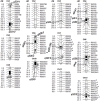Comparative Mapping of Seed Dormancy Loci Between Tropical and Temperate Ecotypes of Weedy Rice (Oryza sativa L.)
- PMID: 28592557
- PMCID: PMC5555466
- DOI: 10.1534/g3.117.040451
Comparative Mapping of Seed Dormancy Loci Between Tropical and Temperate Ecotypes of Weedy Rice (Oryza sativa L.)
Abstract
Genotypic variation at multiple loci for seed dormancy (SD) contributes to plant adaptation to diverse ecosystems. Weedy rice (Oryza sativa) was used as a model to address the similarity of SD genes between distinct ecotypes. A total of 12 quantitative trait loci (QTL) for SD were identified in one primary and two advanced backcross (BC) populations derived from a temperate ecotype of weedy rice (34.3°N Lat.). Nine (75%) of the 12 loci were mapped to the same positions as those identified from a tropical ecotype of weedy rice (7.1°N Lat.). The high similarity suggested that the majority of SD genes were conserved during the ecotype differentiation. These common loci are largely those collocated/linked with the awn, hull color, pericarp color, or plant height loci. Phenotypic correlations observed in the populations support the notion that indirect selections for the wild-type morphological characteristics, together with direct selections for germination time, were major factors influencing allelic distributions of SD genes across ecotypes. Indirect selections for crop-mimic traits (e.g., plant height and flowering time) could also alter allelic frequencies for some SD genes in agroecosystems. In addition, 3 of the 12 loci were collocated with segregation distortion loci, indicating that some gametophyte development genes could also influence the genetic equilibria of SD loci in hybrid populations. The SD genes with a major effect on germination across ecotypes could be used as silencing targets to develop transgene mitigation (TM) strategies to reduce the risk of gene flow from genetically modified crops into weed/wild relatives.
Keywords: comparative genomics; quantitative trait locus; seed dormancy; segregation distortion; weed.
Copyright © 2017 Zhang et al.
Figures




Similar articles
-
Quantitative trait locus and haplotype analyses of wild and crop-mimic traits in U.S. weedy rice.G3 (Bethesda). 2013 Jun 21;3(6):1049-59. doi: 10.1534/g3.113.006395. G3 (Bethesda). 2013. PMID: 23604075 Free PMC article.
-
Contrasting patterns of variation in weedy traits and unique crop features in divergent populations of US weedy rice (Oryza sativa sp.) in Arkansas and California.Pest Manag Sci. 2018 Jun;74(6):1404-1415. doi: 10.1002/ps.4820. Epub 2018 Mar 5. Pest Manag Sci. 2018. PMID: 29205860
-
Genetic analysis of adaptive syndromes interrelated with seed dormancy in weedy rice (Oryza sativa).Theor Appl Genet. 2005 Apr;110(6):1108-18. doi: 10.1007/s00122-005-1939-2. Epub 2005 Mar 22. Theor Appl Genet. 2005. PMID: 15782297
-
Harnessing weedy rice as functional food and source of novel traits for crop improvement.Plant Cell Environ. 2025 Apr;48(4):2498-2521. doi: 10.1111/pce.14868. Epub 2024 Mar 4. Plant Cell Environ. 2025. PMID: 38436101 Review.
-
[Major domestication traits in Asian rice].Yi Chuan. 2012 Nov;34(11):1379-89. doi: 10.3724/sp.j.1005.2012.01379. Yi Chuan. 2012. PMID: 23208135 Review. Chinese.
Cited by
-
Two Contrasting Patterns and Underlying Genes for Coadaptation of Seed Dormancy and Flowering Time in Rice.Sci Rep. 2018 Nov 14;8(1):16813. doi: 10.1038/s41598-018-34850-5. Sci Rep. 2018. PMID: 30429528 Free PMC article.
References
-
- Booth B. D., Murphy S. D., Swanton C. J., 2003. Weed Ecology in Natural and Agricultural Systems Center for Agriculture and Bioscience International Publishing, Wallingford, UK.
-
- Cai H. W., Morishima H., 2000. Genomic regions affecting seed shattering and seed dormancy in rice. Theor. Appl. Genet. 100: 840–846.
-
- Chopra V. L., Prakash S., 2002. Evolution and Adaptation of Cereal Crops Science Publishers, Inc., Enfield, NH.
-
- Delouche J. C., Burgos N. R., Gealy D. R., de San Martin G. Z., Labrada R., 2007. Weedy Rices – Origin, Biology, Ecology and Control. FAO, Rome.
Publication types
MeSH terms
LinkOut - more resources
Full Text Sources
Other Literature Sources
Research Materials
